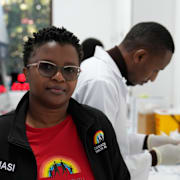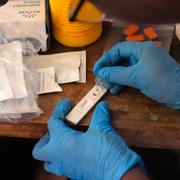
Rapport: Anmärkningsvärda framsteg i kampen mot hiv
Antalet hiv-infektioner minskade med en femtedel under 2010-talet, enligt en stor studie som publiceras i vetenskapstidskriften The Lancet. Dödsfallen kopplade till hiv, vanligtvis andra sjukdomar i ett sent stadie av aids, föll med ungefär 40 procent till under en miljon fall per år.
– Världen har gjort anmärkningsvärda globala framsteg för att kraftigt minska antalet nya hiv-infektioner, säger studiens huvudförfattare Hmwe Kyu.
Minskningarna har huvudsakligen drivits fram av en förbättrad situation i subsahariska Afrika.
Samtidigt finns det flera områden där antalet infektioner inte har minskat, i exempelvis Östeuropa och Mellanöstern har hiv ökat.
bakgrund
Hiv
Wikipedia (en)
The human immunodeficiency viruses (HIV) are two species of Lentivirus (a subgroup of retrovirus) that infect humans. Over time, they cause acquired immunodeficiency syndrome (AIDS), a condition in which progressive failure of the immune system allows life-threatening opportunistic infections and cancers to thrive. Without treatment, the average survival time after infection with HIV is estimated to be 9 to 11 years, depending on the HIV subtype.
In most cases, HIV is a sexually transmitted infection and occurs by contact with or transfer of blood, pre-ejaculate, semen, and vaginal fluids. Non-sexual transmission can occur from an infected mother to her infant during pregnancy, during childbirth by exposure to her blood or vaginal fluid, and through breast milk. Within these bodily fluids, HIV is present as both free virus particles and virus within infected immune cells.
Research has shown (for both same-sex and opposite-sex couples) that HIV is not contagious during sexual intercourse without a condom if the HIV-positive partner has a consistently undetectable viral load.
HIV infects vital cells in the human immune system, such as helper T cells (specifically CD4+ T cells), macrophages, and dendritic cells. HIV infection leads to low levels of CD4+ T cells through a number of mechanisms, including pyroptosis of abortively infected T cells, apoptosis of uninfected bystander cells, direct viral killing of infected cells, and killing of infected CD4+ T cells by CD8+ cytotoxic lymphocytes that recognize infected cells. When CD4+ T cell numbers decline below a critical level, cell-mediated immunity is lost, and the body becomes progressively more susceptible to opportunistic infections, leading to the development of AIDS.
Omni är politiskt obundna och oberoende. Vi strävar efter att ge fler perspektiv på nyheterna. Har du frågor eller synpunkter kring vår rapportering? Kontakta redaktionen



